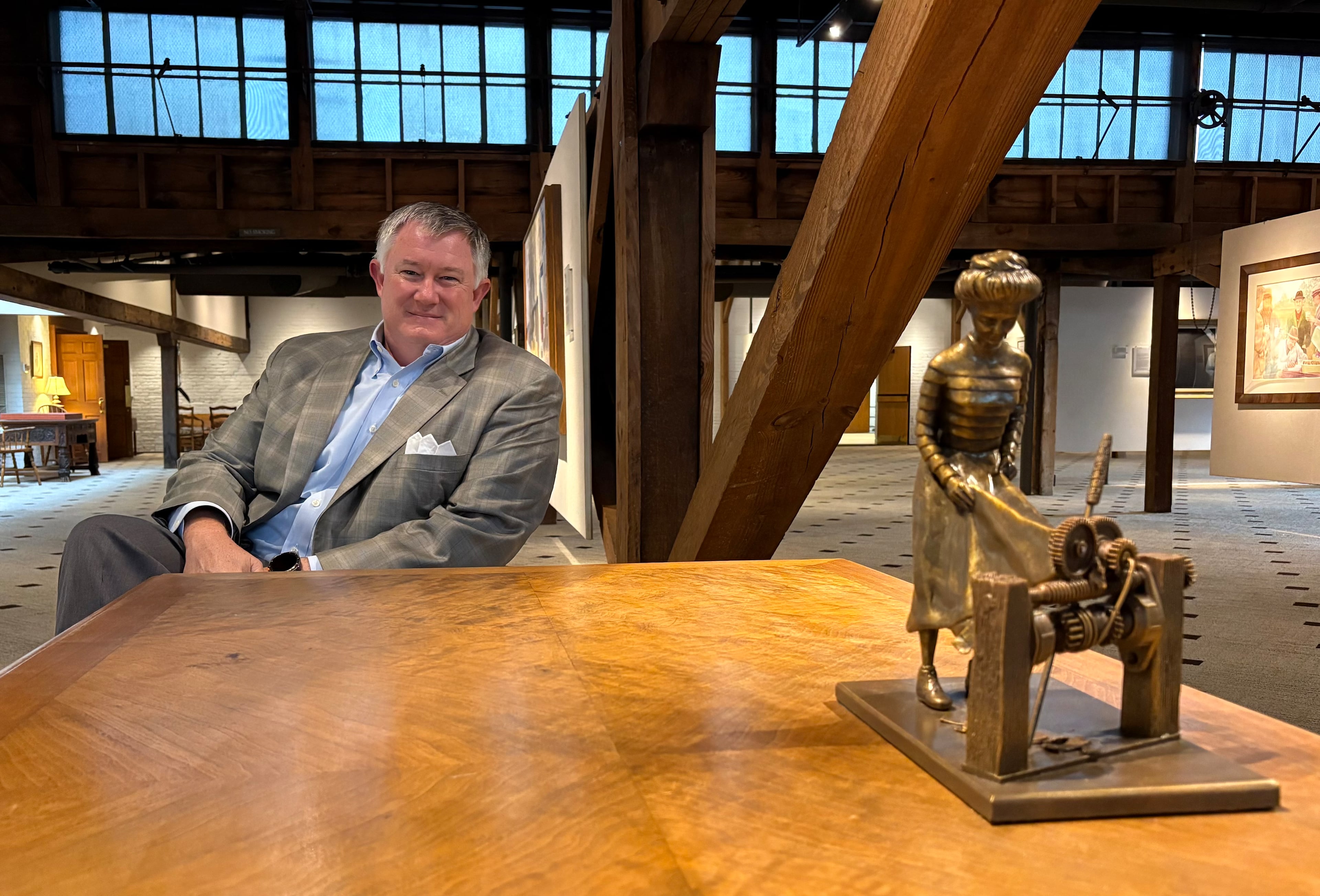Industry shaped Georgia’s second-largest city. Change now defines it.
COLUMBUS — Jim Morpeth smelled more than potential when looking at an abandoned Greyhound bus station in the heart of his hometown.
The restaurateur in 1988 transformed the shuttered structure in downtown Columbus into a quirky barbecue restaurant called Country’s On Broad, even incorporating a bus for additional seating. Morpeth said success wasn’t ensured, given his neighbors.
“When we started business down there, it was all cotton mills,” he said, noting that an adult bookstore was his restaurant’s other prominent neighbor. “And we watched the cotton mills go away.”
Just as diesel fumes were supplanted by the smell of smoked meat, the vacant mills that once spun denim and cotton eventually found new life as apartments, event venues and other commercial hubs. More than three decades later, Columbus, now Georgia’s second-largest city, is approaching another wave of change impacting the businesses that picked up the slack left by the diminished textile industry.
Columbus-based bank Synovus Financial announced in July that it agreed to an $8.6 billion merger with Nashville-based Pinnacle Financial Partners. The blockbuster deal would create the country’s 15th-largest bank, stretching across nine Southeastern states.
If finalized, it will also cost Columbus Synovus’ headquarters. Pinnacle will maintain its banking home in Nashville, while a new holding company will be located in Atlanta.
Synovus is the latest case of déjà vu for Columbus, which has seen several homegrown companies emerge as acquisition targets.
Carmike Cinemas in 2016 was acquired by theater giant AMC. Financial technology company TSYS was acquired by a Fortune 500 company in 2019, and parts of the business are under an agreement to be sold to a new parent. Now Synovus, a bank synonymous with Columbus that was birthed out of the city’s mills in the 19th century, joins the list.
The trend has prompted heartburn in Columbus over fears of divestment. But city leaders and stakeholders say they’re optimistic those companies will remain committed to Columbus, which has shown it can adapt to seismic shifts among its largest employers.
“We’re not going to wring our hands about this. It’s a business decision those businesses had to make,” said Jimmy Yancey, a retired executive for both Synovus and TSYS. “We’re going to just try our best to convince them that Columbus is a doggone good place to do business.”
Columbus is like many Georgia cities outside of Atlanta, defining itself through a few niches.
Fort Benning is an economic engine. The Chattahoochee River, which splits Columbus from Phenix City, Alabama, and was once the lifeblood of the city’s mills, has been reinvented as an urban white-water course and tourist attraction. Columbus State University and corporate interests have revived the city’s downtown.
But the city is perhaps best known for spawning several large public companies, notably Synovus, TSYS and insurance giant Aflac.
“This is fertile ground for (entrepreneurship),” said Audrey Tillman, executive vice president and general counsel at Aflac. “Some major things have come from thinkers on these very streets.”
Even an inkling of reduced investment, let alone the potential of leaving town, throws Columbus on its back foot, dredging up memories of mills boarding their doors. Synovus CEO Kevin Blair understands those concerns.
“People see that (merger) announcement, and they think, ‘There goes Columbus. There goes the Synovus presence in Columbus,’” he said. “But that’s just not the case.”
He emphasized his bank will not abandon its longtime home nor its status as a corporate citizen. Blair said the merger will only trim 5% of both banks’ staff, adding that most Synovus C-suite members will remain in Columbus. He said the deal sets the stage for expansive growth that will bolster investment everywhere the banks touch, including Atlanta, Nashville and Columbus.
Others, like Morpeth, who has called Columbus home for nearly 80 years, are still waiting to see if those promises come to fruition.
“I’ve seen Columbus develop a lot with industry,” he said. “But it bothers me to see the things that were created here leave our town and go to Atlanta.”
‘Go with the flow’
Like most cities, Columbus is a product of its geography.
Straddling the Alabama border, Columbus sits at the northernmost point most boats could travel along the Chattahoochee River. It became one of Georgia’s largest textile hubs, employing tens of thousands.
The Eagle & Phenix Mill — now converted into apartments — serves as the origin story for Synovus, one etched into corporate lore.
In 1888, a mill worker’s dress became tangled in a factory loom, scattering money she had sewn into her hem across the floor. She purportedly saw her dress as the safest place for money storage, but a collection of her co-workers banded together to stock her savings in the mill’s safe, effectively creating a credit union.
“There’s this genuine belief that there is an obligation to protect and (a corporate responsibility) in pushing the community forward,” said Pace Halter, an executive with W.C. Bradley Co., a family conglomerate that owns the mill and played a role in the bank’s growth.

The upstart eventually grew into Columbus Bank & Trust. During the bank’s growth, a banking card division was formed that split into TSYS in the 1980s.
The holding company for CB&T renamed itself Synovus in 1989 and eventually became the parent of the Columbus bank and more than two dozen other community banks, which all took the Synovus name in recent years.
The companies, alongside W.C. Bradley Co., came to define the corporate culture of Columbus.
“The ethos of those companies have really become part of the fabric of who we are,” said Betsy Covington, president and CEO of the Community Foundation of Chattahoochee Valley. “We’ve called it servant leadership for a long time.”
While those companies, Aflac and Carmike steadily grew, the mills buckled under the pressure of expanding international trade.
By the 1990s, most of the city’s textile industry had closed, leaving downtown Columbus without major employment centers. It exacerbated the suburban shift that had taken place for decades in Columbus and other cities, including Atlanta.
“During that time, the shopping center era came, and the downtown basically died,” said Jim Blanchard, Synovus CEO from 1971 to 2005.
Blanchard helped lead what became known as the “Uptown” rebranding.
“He didn’t want to hear the word ‘down’ in our ‘downtown’ because you used to be able to throw a rock down the middle of Broadway at 12 o’clock noon and not worry about hitting anybody,” Columbus Mayor Skip Henderson said. “Nobody was coming down here.”
It was more than just a new name. A sewer overflow mitigation project resulted in a multiuse trail called the Riverwalk, now a 15-mile path that connects Fort Benning to Uptown.
In the early 2010s, the city breached two defunct mill dams and crafted a white-water course, which it now boasts is the largest of its type in the world. In late July, Columbus was named as the host city for the 2028 Canoe Freestyle World Cup and the 2029 Canoe Freestyle World Championship, beating Paris for the latter.
Stuart Rayfield, president of Columbus State University, said the transformation of the river and resulting development in Uptown spurs a sense of local pride.
“Just like the Chattahoochee River, our community has adapted with change over time,” she said. “We will go with the flow.”
Big fish, little pond
The mills weren’t able to compete with cheaper textiles produced abroad, but the city’s other large employers faced different pressures: consolidation.
Blanchard said there was constant pressure to move Synovus to Atlanta during his roughly 35-year tenure as CEO.
“Synovus, headquartered in Columbus, is the only top 100 bank in the country that’s not in a major (metro) district,” he said. “So the temptations or the attractiveness of moving is dramatic as far as the growth opportunities.”
Synovus executives said the timing is right for the Pinnacle merger, a bank founded in 2000 that has rapidly grown. Blair, the Synovus CEO, added, “You’ve got to try to follow where the growth is going.”
The two banks don’t have an overlapping footprint, so it’s primarily an effort to expand through combining their customer pools and existing reputations.
“When you look at banking, the people make it special,” said Jansen Tidmore, president and CEO of the Greater Columbus Chamber of Commerce. “It’s the Columbus people that have grown (Synovus) to the point that it was today.”
Additional focus on Atlanta opens up a broader pool of talent, but it also breaches new forms of competition.
Synovus is by far the largest bank in Columbus with about 60% of market share, Blair said. In Atlanta, it’s about 6%, placing Synovus behind national heavyweights Wells Fargo, Bank of America and Truist.
The Columbus metro ended July with a 5.2% unemployment rate, nearly two percentage points higher than the statewide average. Atlanta was at 3.5%.
Talent retention is another dynamic that shifts with scale. In 2019, TSYS was acquired by Global Payments for $21.5 billion. Yancey, the former TSYS and Synovus executive, remembers Global leaders complaining of their workers “getting poached by somebody across the street” in Atlanta and other large cities.
Columbus doesn’t have the same amount of cutthroat competition.
“You are the big fish in Columbus,” he said. “If you move to Atlanta, you’re just another company up there.”
TSYS and Global did not respond to multiple requests for comment. FIS, which in May announced a $13.5 billion deal to acquire part of TSYS from Global Payments, declined to comment, citing the pending acquisition.
Rayfield of Columbus State said her university’s curriculum is also tailored to suit the needs of the area’s largest employers. Atlanta’s higher education system similarly has programs intended to funnel talent into certain fields, but she argues it’s easier to get lost in the shuffle in the big city.
“We can say, ‘Great, we will embed that into our curriculum today,’” Rayfield said. “Other institutions … they’ve got thousands of companies. They can’t be responsive in that way.”
It’s too soon to know whether increased success and investment in Atlanta will flow downstream to Columbus or act as a logjam. But even if longtime companies change their marquees or chase growth, Columbus stakeholders say it’s a testament to the entrepreneurial track record the city has cultivated.
“We’ve got growing pains, but that means we’re growing, right?” Halter of W.C. Bradley Co. said. “These aren’t dying pains.”



